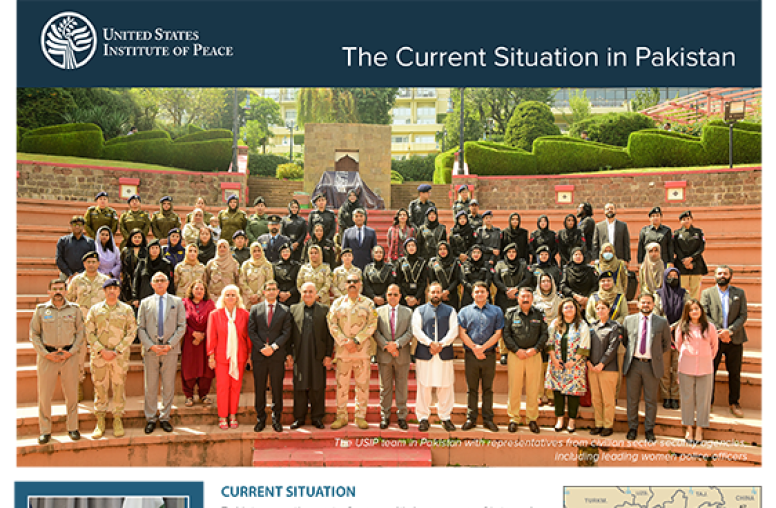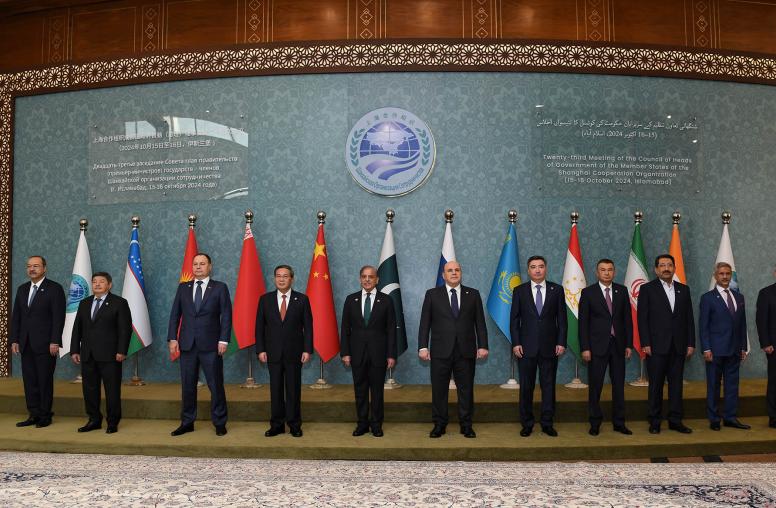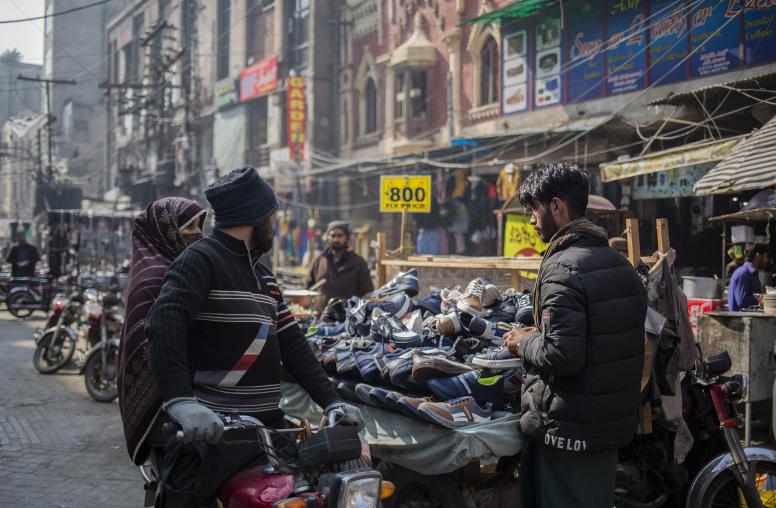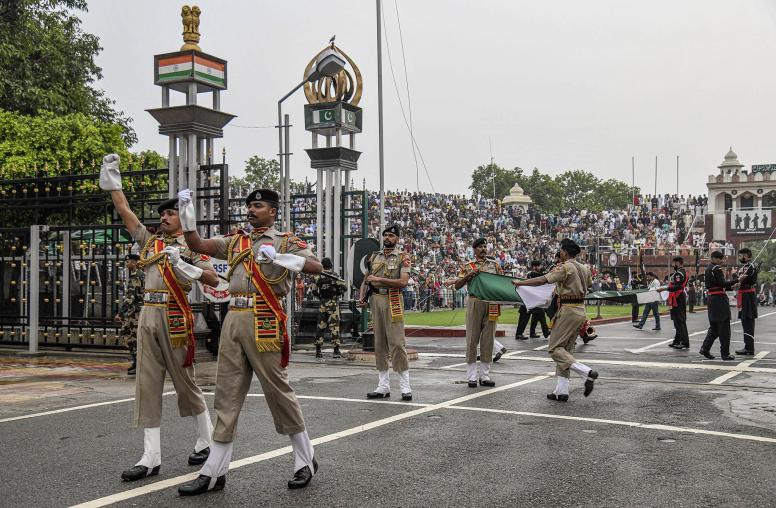Nationalistic Narratives in Pakistani Textbooks
History textbooks capture a state’s official narratives regarding particular events, territory, groups, or phenomena. These narratives reflect and constitute a state’s national identity and can generate the potential for conflict because of their divisiveness. This brief summarizes initial baseline research on Pakistani textbooks, revealing the importance of bureaucratic politics, and highlights several implications for education reform and national and international stability.
Summary
- History textbooks encapsulate a state’s official narrative for its citizens, and depending on their content, can create and sustain chauvinistic attitudes toward out-groups.
- Though complex and multifaceted, all official narratives seek to answer three questions: Who are we? Where do we belong? How far back in time do we go?
- In Pakistan, nationalistic narratives took hold during General Zia-ul-Haq’s decade in power in the 1980s, aided by the Jamaat-e-Islami (JI) party.
- As part of a push for “enlightened moderation,” General Pervez Musharraf’s education reforms during the 2000s attempted to deradicalize Pakistani textbooks, but his attempts failed due to JI’s influence within the bureaucracy.
- Any reform of Pakistani textbooks will have to be led by political parties at the national level; however, the 2010 eighteenth amendment that devolves education to the provinces complicates this task.
Background
History textbooks are not only of interest to the school students that they are written for, but also to scholars, policymakers, and political elites. These textbooks capture important, official state narratives, and depending on their form and content, can often generate conflict.
First, the narratives themselves can cause tension across or within states. For example, relations among China, Japan, and South Korea are often strained by the content of official narratives,1 such as those surrounding the Nanjing Massacre.2 Internally, domestic political actors often disagree on historical perceptions, such as who bears responsibility for slavery in the United States,3 who the main protagonists are in a particular state’s national history,4 or how ethnic minorities, women, or the working class are portrayed.5 These domestic disputes generally bring a lower risk of violence; they are typically addressed through the courts,6 legislatures,7 or bureaucracies.
Second, the narratives can drive the potential for violence by creating or reinforcing divisive attitudes toward out-groups.8 This is a more gradual cause of conflict, but arguably more important. Following the cataclysm of nationalism and destruction that was World War II, the United Nations Educational, Scientific and Cultural Organization initiated a textbook reform effort, claiming in its charter that “since wars begin in the minds of men, it is in the minds of men that the defenses of peace must be constructed” and publishing A Handbook for the Improvement of Textbook and Teaching Materials four years later.9 In South Asia, research has found that Pakistani textbooks used in social studies, history, and Pakistan studies feature statements that are “entirely one-sided, in favor of Muslims and Pakistan,”10 and contain “a strong current of exclusivist and divisive tendencies,”11 especially against religious minorities.12 In India, meanwhile, some eleven-year-olds are taught that meat eaters “easily cheat, tell lies, forget promises, are dishonest and tell bad words, steal, fight and turn to violence and commit sex crimes.”13
Nationalistic Narratives in Pakistani Textbooks
Though complex and multifaceted, nationalism encompasses three basic concerns. First, who are “we”? Is the boundary that divides “us” and “them” based on geography, creed, religion, caste, race, language, or something else? Second, where are we from or, in a different formulation, where do we belong? The presence of a historic “homeland” that a group lays claim to is essential to national identity. Third, how far back in time do we go? Though nationalism is a relatively modern political force, nationalists do not believe so. To the contrary, tracing a lineage to bygone eras, no matter how historically tendentious, is a core element of nationalist projects.
This third element of narrative creation—the collective memory and occlusion of particular periods and dates14—forms the basis of the author’s broader research on South Asian textbooks, aimed at delineating how states create and sustain positive images of their nations and negative ones of others. This brief focuses on the treatment of two dates in particular in Pakistani textbooks: 1947, when India and Pakistan won national independence, and 1971, when Bangladesh won independence.
Bureaucratic Politics of Education
To understand Pakistan’s treatment of these dates, it is important to first understand the politics surrounding the education bureaucracy. The education sector can often be the source of political patronage: The provincial ministries of education collectively constitute the largest public sector employer in the country, and in the form of teachers’ salaries, represent a bounty of economic and political capital for distribution to party workers. Moreover, it is the sector that ideological actors, or those significantly invested in questions of national identity, pay great attention to.
Education became a federal subject in Pakistan in 1976, before being devolved to the provinces under the 2010 eighteenth amendment to the constitution. Each provincial ministry of education has a curriculum wing and a textbook board, which reports directly to the minister. Board members are usually drawn from the ranks of the education bureaucracy or from party or clan networks; and their level of expertise in global educational standards, pedagogy, or established best practices is minimal. The boards develop textbooks in liaison with influential private-sector publishers; once written, the books are sent to the ministry, which approves them for general use in the market.15 Schools have little leeway in using books other than those prescribed. Even private schools, which technically enjoy the right to choose their own books, will use officially prescribed books for those grades that administer standardized exams.
Ideologically, grand shifts took place in history education following General Muhammad Zia-ul- Haq’s coup in 1977. Zia’s plans for Islamizing education were encapsulated in the 1979 National Education Policy and carried out with the aid of the JI party, which dominated the education bureaucracy thanks to a relatively educated rank and file, a heightened interest in questions of national ideology, and Zia’s patronage. As one former ministry of education official stated simply, “In Pakistan, nationalism construction starts from the armed forces, and is articulated by right wing religious parties, especially JI. They have been instrumental in developing the mainstream narrative on nationalism.”16 Most other parties simply do not understand the power of controlling education policy; in the words of another former ministry official, “Political parties other than Jamaat have not done their homework.”17
JI control of the education bureaucracy impeded both the pace and extent of deradicalization undertaken by another military dictator, Pervez Musharraf, in 2002 and 2006. Musharraf’s failures speak to a more general difficulty associated with reform: It is not enough for elites to have political will or an expressed desire for change. A holistic strategy for education reform has to consider the ideological makeup of institutions where the reforms must be implemented. Indeed, the JI’s staying power within the bureaucracy means that it need not win votes to influence curriculum and textbooks—though electoral victories surely help, as evinced by its recent successes in the removal of “secular chapters” and “objectionable material” from textbooks in Khyber Paktunkhwa.18
“Big” Dates in Pakistani Textbooks
It is not surprising that the events of 1947 are discussed more frequently than those of 1971 in Pakistani textbooks. However, even the terms in which the years are discussed are revealing. The dominant theme of narratives on 1947 is liberation. One Class 10 textbook from Punjab notes simply that “On 1st October 1947, while addressing the officers of the Government of Pakistan, he [Jinnah] said that their mission was the establishment of a state where they could live like free people in their own socio-cultural set up necessary for the promotion of social justice and Islamic Ideology.”19 Another passage states that “Pakistan emerged as an independent state on the map of the world on 14 August, 1947. The basic purpose of getting Pakistan was to provide the people an environment wherein they could lead their lives according to the basic principles of Islam. On the basis of two Nation Theory people of subcontinent launched a freedom movement and got Pakistan.”20
The events of 1971 are discussed in predictably more grim terms in Pakistani textbooks. However, little is stated about the structural causes of Bengali disaffection with the Pakistani state. To the contrary, the books emphasize the geopolitical implications of the ensuing civil war. As one Pakistan studies textbook notes, “No instant and effective operation could be done in East Pakistan because of vast distance of land as well as disconnected air communication and non cooperation of the local people. Consequently, our army had to surrender. Eventually India succeeded in achieving her objectives and East Pakistan appeared on the map of the world with the name of Bangladesh on 16th December, 1971.”21 Rather than educating readers about the deeper causes of the territorial split, textbooks gloss over state culpability in both the outbreak of, and violence during, the crisis. Instead, they highlight how regional or global powers conspired to create Bangladesh, with little fidelity to the historical record.
Implications
Though more general lessons on nationalist narratives must await a deeper, comparative study of textbooks in other South Asian countries, several implications are apparent from this baseline analysis of Pakistani textbooks.
First, nationalistic narratives should concern both domestic citizens and international observers because of their role in generating hostility and the potential for violence. Second, more than most issues, textbook politics create path dependence—whereby decisions in the past strongly circumscribe one’s freedom of action in the present. If a certain point of view is promoted in historical accounts, then by virtue of this perspective becoming “official,” it will be disproportionately more difficult to remove or challenge such a narrative later.
Third, reform that pushes for or against particular narratives must be attuned to political realities. To prevent bureaucratic inertia from impeding reform efforts, political elites must take a holistic approach to the politics of education, with due consideration to the staffing of the curriculum wing and textbook board; the political capital afforded to reformers in the midst of electoral and coalitional politics; and the formal and informal ties between private-sector publishers and education bureaucracies that privilege certain narratives over others.
Fourth, and relatedly, any attempt at large-scale reform of Pakistani textbooks must be conducted by political parties at the federal level. One side effect of the 2010 devolution of education to the provinces has been that ideological debates that would normally have bubbled up nationally have been circumscribed to the provinces, such as Khyber Pakhtunkhwa. Civil society can, at best, help establish the parameters of good policy, but without a debate conducted by major political parties at the federal level, Pakistan’s national narrative will likely remain ossified from the 1980s. For this to occur, parties will have to be convinced of the importance of education politics beyond their patronage potential.
Notes
- Zheng Wang, “National Humiliation, History Education, and the Politics of Historical Memory: Patriotic Education Campaign in China,” International Studies Quarterly 52 (2008): 801.
- Alexander Bukh, “Japan’s History Textbooks Debate,” Asian Survey 47 (2007): 694–95.
- James W. Loewen, Lies My Teacher Told Me: Everything Your American History Textbook Got Wrong (New York: Simon & Schuster, 1995), chapter 5.
- Yiannis Papadakis, “Narrative, Memory and History and Education in Divided Cyprus: A Comparison of Schoolbooks on the ‘History of Cyprus,’” History & Memory 20 (2008): 133; and Wang, “National Humiliation, History Education, and the Politics of Historical Memory,” 791.
- Papadakis, “Narrative, Memory and History and Education in Divided Cyprus,” 139-40; Ken Montgomery, “Banal Race-thinking: Ties of Blood, Canadian History Textbooks and Ethnic Nationalism,” Paedagogica Historica: International Journal of the History of Education 41 (2005): 317; and Julian Dierkes, “The Decline and Rise of the Nation in German History Education,” in Hanna Schissler and Yasemin N. Soysal, eds., The Nation, Europe, and the World: Textbooks and Curricula in Transition (New York: Berghahn Books, 2005), 84, 89.
- Yoshiko Nozaki, War Memory, Nationalism and Education in Postwar Japan, 1945–2007 (New York: Routledge, 2008).
- Loewen, Lies My Teacher Told Me, 141.
- Wang, “National Humiliation, History Education, and the Politics of Historical Memory,” 785, 799; and Rafi Nets-Zehngut, “The Passing of Time and the Collective Memory of Conflicts: The Case of Israel and the 1948 Palestinian Exodus,” Peace & Change 37 (2012): 255.
- Elie Podeh, The Arab Israeli Conflict in Israeli Textbooks (New York: Bergin and Garvey, 2002), 5.
- Madiha Afzal, “Education and Attitudes in Pakistan: Understanding Perceptions of Terrorism,” Special Report 367 (Washington, DC: U.S. Institute of Peace, 2015), last accessed June 1, 2016, www.usip.org/sites/default/files/SR367-Education-and-Attitudes-in-Pakistan.pdf.
- A.H. Nayyar and Ahmad Salim, The Subtle Subversion: The State of Curricula and Textbooks in Pakistan (Islamabad: Sustainable Development Policy Institute, 2004), vi, last accessed June 1, 2016, http://unesco.org.pk/education/teachereducation/reports/rp22.pdf.
- Rezaul Laskar, “Pakistan’s Textbooks Close Door on Peaceful Future with India: US Study,” Hindustan Times, April 16, 2016, last accessed June 1, 2016, www.hindustantimes.com/world/pakistan-s-textbooks-close-door-on-peaceful-future-with-india-us-study/story-QUVc31DeY-tRo5enepI2oYI.html.
- “Five Bizarre ‘Lessons’ in Indian Textbooks,” BBC News, September 23, 2015, last accessed June 1, 2016, www.bbc.com/news/world-asia-india-34336826.
- As William Green, “Periodization in European and World History,” Journal of World History 3 (1992), 14, notes, divisions of historical narratives into distinct periods “inescapably reflect the values of the classifiers.”
- Mariam Chugtai, “What Produces a History Textbook?” (PhD dissertation, Harvard Graduate School of Education, 2015).
- Interview with former ministry of education official 1, Islamabad, December 2015.
- Interview with former ministry of education official 2, Islamabad, December 2015.
- Asad Zia, “Revised Curriculum: JI Pushes Through its Agenda on Textbooks in K-P,” The Express Tribune, October 27, 2014, last accessed June 1, 2016, http://tribune.com.pk/story/781717/revised-curriculum-ji-pushes-through-its-agenda-on-textbooks-in-k-p/.
- Pakistan Studies for Class [Grade] 10, Punjab Textbook Board, 2004.
- Ibid.
- Pakistan Studies for Class [Grade] 9, Punjab Textbook Board, 2014–15.
About this Brief
Ahsan Butt is an assistant professor at the School of Policy, Government, and International Affairs at George Mason University. His work focuses on ethnicity and nationalism, international security, and South Asia. This brief summarizes initial field research supported by the U.S. Institute of Peace on the politics surrounding history textbooks in Pakistan and their implications for conflict. The research is part of a broader study on states’ construction of nationalistic narratives.



